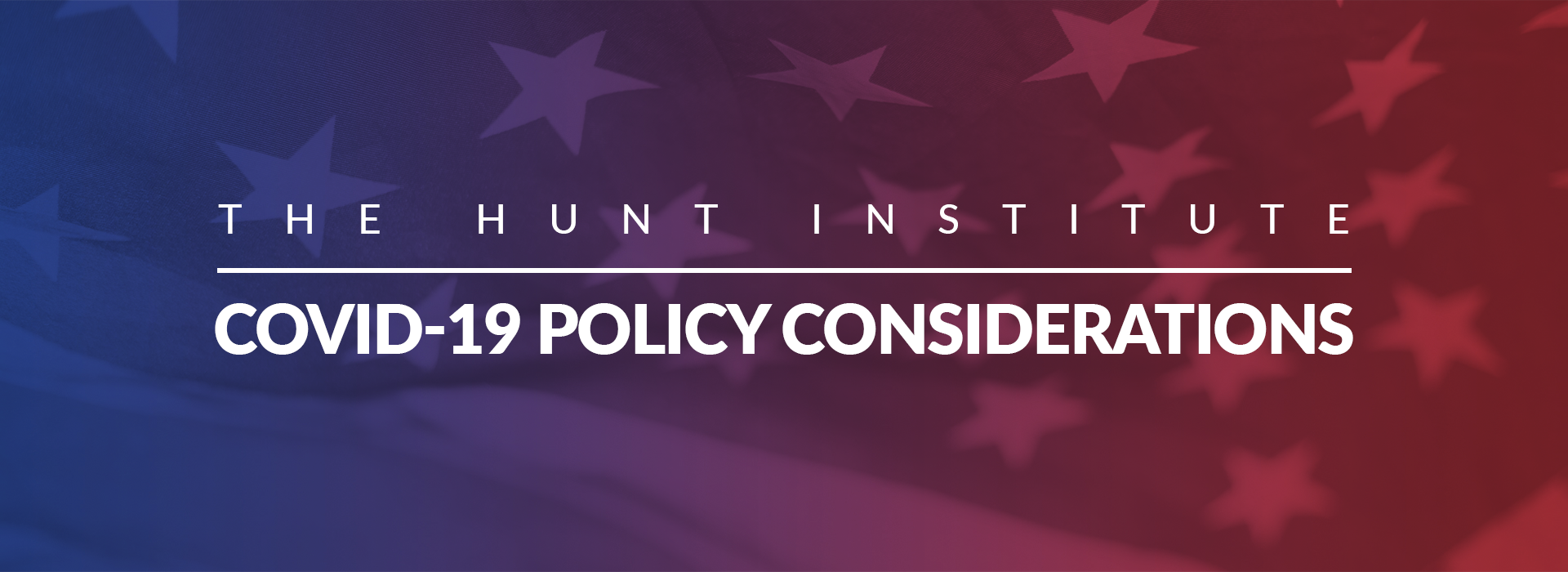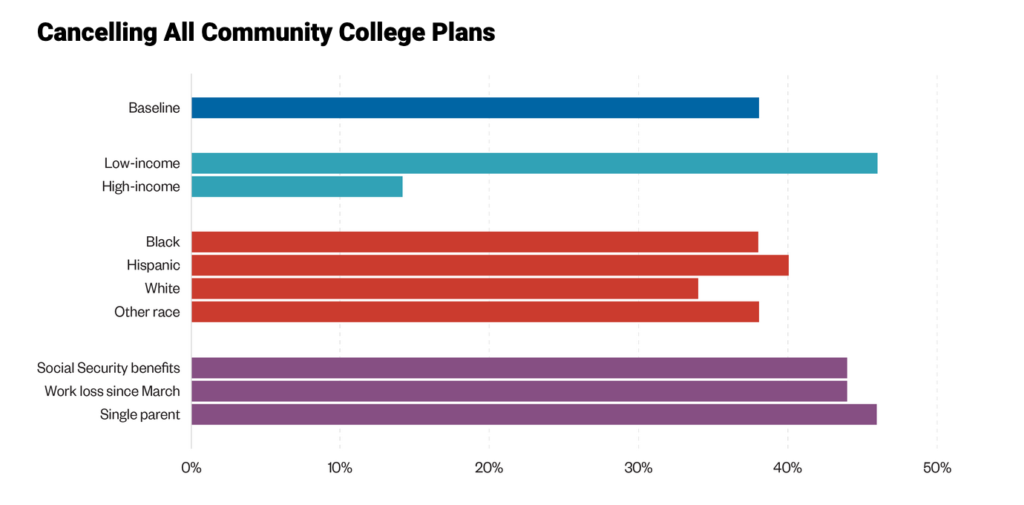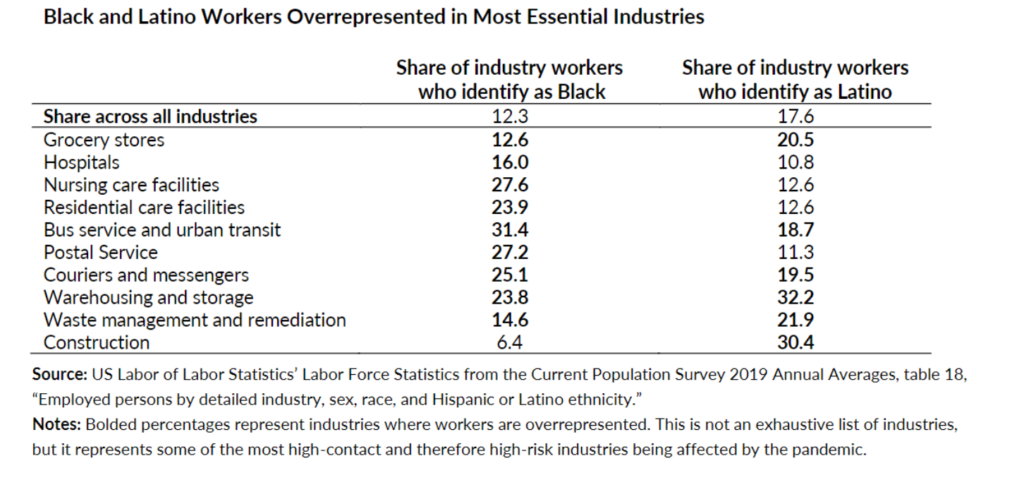

February 5, 2021
COVID-19 has threatened college completion for millions of students and exacerbated inequities in higher education. Last fall, institutions of higher education (IHEs) noticed a concerning trend: low-income students are most likely to drop out or not enroll in higher education at all. In the spring of 2020, student surveys suggested that four-year IHEs would suffer the most as students turned to enroll at two-year institutions, which have a lower cost of attendance for students, until the pandemic subsided. However, research by the National Student Clearinghouse Research Center finds two-year IHEs showed the largest enrollment decline among low-income students.
Surveys conducted by the U.S. Census Bureau also show that the pandemic has negatively impacted community college enrollment, with more than 40% of reporting households indicating that a prospective student would cancel all plans to pursue higher education; another 15% would be enrolling in fewer classes.
The COVID-19 pandemic has widened equity gaps as more low-income students and students of color, specifically those enrolled in two-year universities, leave higher education.
 Belfield, C, & Brock, T. (November 2020). Behind the Enrollment Numbers: How COVID Has Changed Students’ Plans for Community College. Community College Research Center. Retrieved from: https://ccrc.tc.columbia.edu/easyblog/covid-enrollment-community-college-plans.html
Belfield, C, & Brock, T. (November 2020). Behind the Enrollment Numbers: How COVID Has Changed Students’ Plans for Community College. Community College Research Center. Retrieved from: https://ccrc.tc.columbia.edu/easyblog/covid-enrollment-community-college-plans.html
As community colleges disproportionately serve demographic groups that have been hardest hit by the pandemic, such as students of color, rural students, and low-income households, these institutions face difficult challenges in serving the needs of their student body.
First, households with a student enrolled in community college were more likely to report concerns about contracting coronavirus or having to care for someone infected, than households with four-year students. This correlates to long-standing systemic health and social inequities that have put many minority groups at increased risk of contracting the coronavirus. Evidence shows that Black and Latino workers are less likely to be able to telework, have a higher risk of losing their job, and are over-represented in essential industries.

Community college students were also more likely to report financial aid challenges and indicate affordability as a major factor for unenrollment. As the pandemic exacerbates the existing wealth gap, many students are struggling not only to cover the cost of tuition but the cost of books, groceries, and other essentials. As college campuses transition to full online instruction, many students who qualify for the federal work-study program – a program that provides part-time employment for students — have been left to navigate the new regulations in place. The US Department of Education provided flexibility for students whose campuses suspended in-person classes in the spring, but individual schools have the opportunity to regulate this change. Some institutions have provided other alternatives such as grants to replace work-study aid, offering work-study on a case-by-case basis, or offering student loans.
Lastly, one of the biggest challenges brought forth by the coronavirus pandemic is the switch to online learning and the need for access to reliable devices and internet connection. Community college leaders voiced concerns regarding their students’ lack of internet access at home. Some colleges, such as Caldwell Community College, partnered with Google to provide Chromebooks to students and many others have aimed to set up reliable hot-spots near their schools. Unfortunately, students of color make up almost half of students reporting that they do not have reliable access to Wi-Fi.
Community colleges have often been leaders in crisis response, as these institutions emphasize affordability, flexible education, and strong connection to local communities. Many students, especially those from underrepresented backgrounds, rely on these higher education institutions to provide them with opportunities for upward social mobility.
While millions of students have been impacted by the consequences of the COVID-19 pandemic, community colleges, who disproportionately serve students of color and low-income backgrounds, need additional support to promote equitable access to higher education.
Support Potential Students | Evidence suggests that fewer low-income students have decided to head towards higher education. Students from low-income backgrounds have additional barriers to enrollment and education stakeholders should consider best practices to support increased enrollment from this marginalized group. Best practices to support low-income students can educate students on the basics of college while they are still in high school.
First-generation students have limited information regarding the application and enrollment process, therefore local and district stakeholders should consider implementing programs that aim to educate and provide resources to students seeking to enroll in community college courses. The American Council on Education also recommends local community college partnerships with high schools to prepare and inform students of the college process.
Push Mental Health Initiatives | As the pandemic continues to have deep and lasting consequences on higher education, student mental health and wellness has become a significant concern. COVID-19 has exacerbated the need for student mental health as students, specifically from marginalized backgrounds, show increasing reports of anxiety and depression. Education stakeholders and policymakers should advocate and support programs to ensure community college staff have training in basic trauma-informed communication and in handling potentially dangerous situations.
Advocate for Federal Assistance | State and district policymakers should consider advocating for federal assistance to support community colleges and their students. Last spring, the federally funded Coronavirus Aid, Relief, and Economic Security (CARES) Act allocated almost $14 billion in emergency funding for higher education. Many institutions used this funding to address student financial insecurity and enhance technology access.
Unfortunately, the structure of the CARES Act left many institutions with under-resourced students without funding. CARES Act funding was based on the number of full-time-equivalent students enrolled, which negated institutions with large numbers of part-time students. Therefore, while community colleges educate roughly 47 percent of students, these institutions only received about 27 percent of the CARES Act funds. In a study by the Center for American Progress, Ben Miller, the group’s vice president of postsecondary education, highlights how community colleges received a lower share of funds. As affordability remains a crucial factor in obtaining higher education, district and state stakeholders should consider advocating for alternative funding distribution strategies such as a “headcount” formula based upon the number of Pell Grant recipients [Full-Time Equivalent (FTE) recipients and non-Pell FTE enrollment). As affordability remains a crucial factor in obtaining higher education, it remains especially important to distribute resources to the schools that are serving students with the greatest financial need.